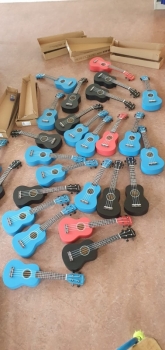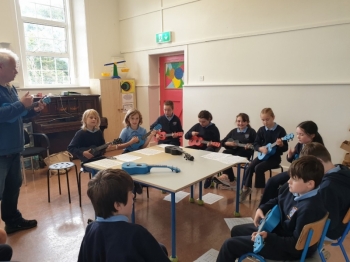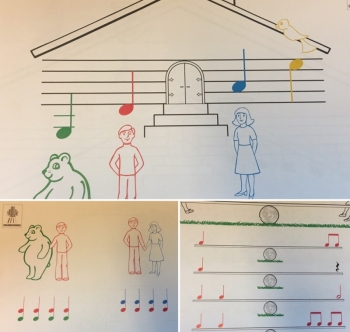Music - Colourstrings & Ukulele Lessons
We have a fantasic music programme on offer to our students in Scoil Cholmáin. The junior half of the school (infants to second class) work on the Colourstrings music programme. This programme is based around understanding the elements of music. The lessons begin to train the musical ear and allow children to understand the basic building blocks of music: pitch, rhythm, tempo, dynamics etc.
As the children move into the senior half of the school (third class - sixth class) they learn how to play an instrument - the ukulele! Children will learn tuning, strumming/rhythm, accompaniment, melody, singing, hand coordination, sight-reading and many other skills while learning to play the ukulele.
Colourstrings
The Colourstrings philosophy and ethos is guided by the principles of the great Hungarian composer and music educator Zoltán Kodály (1882 – 1967).
The Colourstrings method fosters and shares a child-centred approach to music education, developed by internationally renowned string pedagogue Geza Szilvay and his brother Czaba. This is a further development and refinement of Kodaly’s principles built specifically for young children to challenge and inspire them with a love for music.
Key principles of the Kodály approach to music education:
- Central to his philosophy and principles of music education is the belief that “music is for everyone.” Kodály believed that all children, given the right opportunities (the right training at the right time), can learn to sing well, have their inner ear trained, become musically literate (learn to read and write music notation), and if they wish, learn to play a musical instrument.
- Children should be exposed to music at an early age and the training should start in a playful and natural way.
- Good quality children’s songs and folk material provide the starting point for all musical activities.
- Children learn a large repertoire of simple melodies through which they absorb unconsciously the basic building blocks of music: pitch, rhythm, tempo, dynamics etc.
- Sound before the symbol. Children “experience” the elements of music through singing and moving before these elements are made conscious, named and expressed in musical notation.
- Before starting the study of an instrument children should have preparatory training in pitch and rhythm, have their inner hearing developed and have even a rudimentary knowledge of music notation.
- Musicianship training should continue alongside instrumental training to sustain the development of aural ability.
Ukulele Lessons
Ukulele lessons occur weekly from third class to sixth class. This is an excellent opportunity for our students to learn how to play an instrument. We have purchased a class set of ukuleles that will remain in school - ready for our legendry impromptu concerts in the summer term sunshine!
Making music with a ukulele is a great group learning experience. It is a fun way to learn the elements of music. Ukuleles are a good size for storing at home or in school, very reasonably priced and they contain lots of levels of complexity. A ukulele is also easy to carry and just the right size for little hands. They also sound good straight away! Children can learn songs quickly and easily which increases self-esteem and motivation to learn.
Our groups are divided by class so that each class group will have a 45 minute lesson . This allows Rang a 3, 4, 5 & 6 to each get their own lesson.
To make the most of the lessons it is important to practice at home. When learning a new instrument experts recommend that you practice for 20 minutes a day, five times a week.
We look forward to hearing our musical maestros at work!
- Teaches Patience.
- Creates Responsibility.
- Boosts Self-Esteem.
- Improves Reading Skills.
- Exposes New Cultures.
- Enhances Coordination.
- Promotes Math Skills.
- Encourages Self-Expression.




